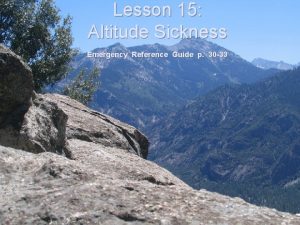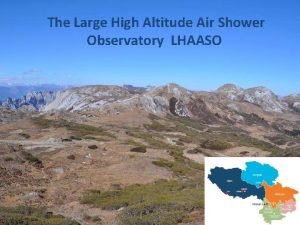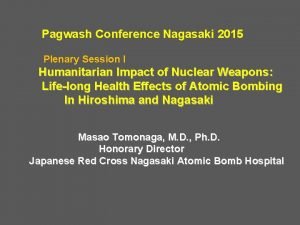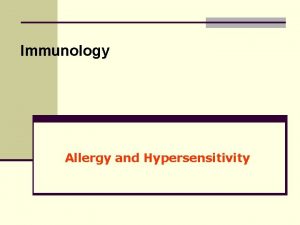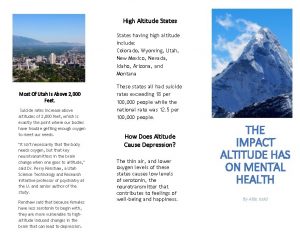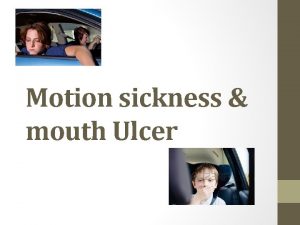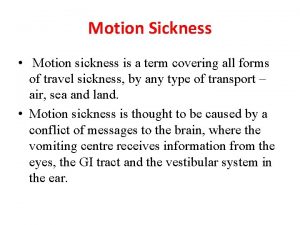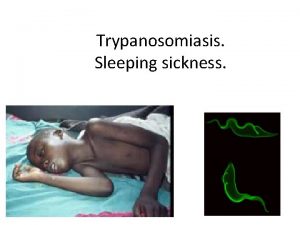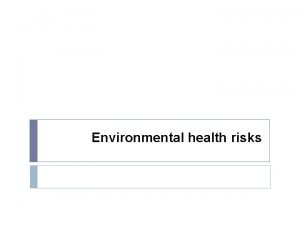High Altitude Sickness Terminology for High Altitude Sickness













- Slides: 13

High Altitude Sickness

Terminology for High Altitude Sickness • AMS – acute mountain sickness • Apnea – cessation of breathing • Edema – local or systemic excesive accumulation of body fluids • HACE – high altitude cerebral edema • HAPE – high altitude pulmonary edeme • Hypobaric hypoxia – dec level of O 2 in ambient air due to altitude

Altitudes greater than 10, 00 feet place operators at risk • Sx listed as immediate and long term in exposure and display • Initial immediate response to altitude is hyperventilation triggered by hypoxia • Over a period of time the chemical stimulation causing hyperventilation will reverse – this may take from 10 -14 days

60 -80% of respiratory symptoms occur within 7 -10 days of exposure • Acclimation to high altitude is effective in reducing this • Acclimation cannot be achieved in less than 10 days

Is your unit going above sea level? • Medical threat assessment for terrain • Paskistan army performs well above 4, 000 m due to prolonged acclimation • Acclimate your personnel as/when possible

Progression • Hyperventilation begins to alter the acid base balancee • Decreased CO 2 can seriously alter the effectiveness of the cardio vascular system • Cellular walls begin to break down and fluid accumulation begins • Initial Sx of headache occur for this increased intercranial pressure related headache • Recognition of this early onset Sx and descending will abate serious condition later

Despite Acclimation Sx may still occur • Sx vary from mild to life threat • All are mission limiting for the soldier and cannot be ignored • HAPE & HACE are life threats without ALS intervention

Risk Factors • • • Degree of acclimation Ascent rate Height achieved Altitude soldier sleeps at *Fitness level of soldier population is not commonly a protective measure ensuring protection from Altitude Sickness

Initial Presentation of Acute Mountain Sickness (AMS) • Headache in a recently arrived person at altitudes greater than 2500 m • GI distress common • Insominia, dizziness, fatigue is the progression

HACE / HAPE • Clinical Dx made after severe symptoms to include respiratory distress and marked decreased level of consciousness • Evidence of retinal hemorrhage is evidentiary to above • Drowsiness to stupor is a common patient presentation

Management 1. Stop further ascent 2. Descend as soon as practical at 1 st signs of severe symptoms

Medical Therapy • Somestimes descending a few hundred meters is enough to reverse symptoms Use of a portable HBO chamber will improve the condition 2 PSI over ambient will simulate a 2500 m drop in altitude

Summary • Medical threat assessment when about to operate above 2500 m • Acclimate early • Expose slowly over a period of 2 wks • Descend or seek ALS before Sxs progress • Mild AMS can still affect mission effectiveness • HACE/HAPE are life threats descend!
 Altitude sickness
Altitude sickness Large high altitude air shower observatory
Large high altitude air shower observatory Shibu lijack
Shibu lijack Pagwash
Pagwash Serum sickness hypersensitivity type
Serum sickness hypersensitivity type Decompression sickness
Decompression sickness Cyber sickness cures
Cyber sickness cures Comic relief literary definition
Comic relief literary definition Hezekiah sickness and recovery
Hezekiah sickness and recovery Sleeping sickness disease
Sleeping sickness disease Lcc sickness policy
Lcc sickness policy Nhs sickness
Nhs sickness Nhs sickness
Nhs sickness Sewage sickness
Sewage sickness
